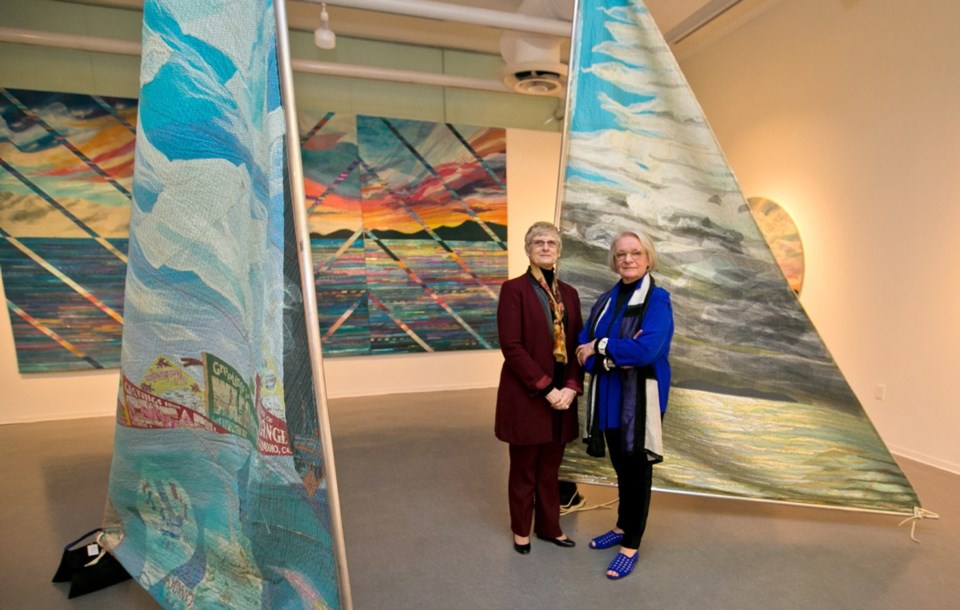When: Opens Friday, 7 to 10 p.m. Curator/artist talk Saturday, 2 to 3 p.m. Continues through April 28
Where: Art Gallery of Greater Victoria
Tickets: Admission by donation at opening. Regular gallery admission $13 adults, $11 seniors/students, $2.50 youth, $28 family, children and members free
As textile artist Carole Sabiston looked at her work on the walls of the Art Gallery of Greater Victoria this week, it felt like a homecoming.
The local artist said she was getting reacquainted with some pieces she’d made as far back at the 1960s, which were gathered together from private and public collections for a retrospective show of her work.
“Just seeing them together is like having all of one’s children and cousins come home for a family reunion,” Sabiston said.
On one wall, a large landscape stitched together in strips of fabric looks across the water from the Songhees to the West Shore. In another room, a rainbow of Parisian silk thread stitches gives movement to the portrait of a friend. And further on, P.K. Page’s poem Planet Earth, likening Earth to fabric that must be cared for, is stitched on dinner napkins from the 1930s that keep their creases:
“It has to be loved the way a laundress loves her linens,” it begins.
Creating works with strips of fabric, using clothing labels as script and texturing them with careful stitching are staples of Sabiston’s unique method. But the same style that eventually earned her international renown nearly limited her early in her career.
“I call it textile assemblage,” Sabiston said.
It was a natural transition from painting, she said. Sabiston had begun adding fabrics to her paintings in a collage style, but soon moved entirely to textiles, when the smell of the oil paint started getting to her.
“I could manipulate [textiles] in ways that I wanted to and I could use reflective fabrics, which one can’t do in painting, getting much more kinetic energy,” she said.
Working with textiles provided some challenges, however.
As Sabiston described it, it was difficult to get her pieces into public spaces in the 1960s and ’70s because it was considered “women’s work” or “craft.”
“That’s dissipated now completely,” she said. “But it was a struggle. Many of us tried to break that barrier and eventually got there.”
Working in Victoria provided another hurdle — the isolation made it more difficult to get representation at Vancouver galleries and beyond.
“As Emily [Carr] said, we’re on the edge of nowhere. So that was discouraging for a long time in my work.”
But Sabiston said she couldn’t not make art, so she persevered, and curators eventually began seeing more than craft in her work.
“I didn’t think about it too much, I just kept doing it,” she said.
Now, Sabiston’s work is represented in collections such as the Canada Council Art Bank, Canadian Museum of Civilization and provincial archive, in addition to dozens of solo and group exhibitions across Canada and Europe. Victoria audiences may know it from Munro’s Books, Government House and other local venues.
Sabiston received the Saidye Bronfman Award for Excellence in the Crafts in 1987, and later the Order of B.C. and the Queen’s Diamond Jubilee Medal.
Guest curator Pat Bovey, who directed the gallery from 1980 to 1999, met Sabiston soon after Bovey moved to Victoria. She said Sabiston’s work lies outside the realm of “fabric art.”
“I don’t put her there,” Bovey said. “We stay away from the word ‘fabric.’ We stay away from the word ‘craft.’ Craft is how you do it or how well you do it; the visual artist is, what are the ideas and how do you convey those ideas?”
Bovey has written a companion book, released in conjunction with the show, exploring the technique, content and context of Sabiston’s work. She curated the works to include pieces from the 1960s to present, from hand-stitched through machine-stitched, from really small through really large and from preliminary sketches through finished works. Emphasized throughout the show are larger themes that recur through Sabiston’s work — from esthetic to environmental concerns — represented through the four elements.
“What is her impact on Canadian art? It’s huge,” Bovey said.
Munro’s Books hosts An Evening with Carole Sabiston, free, Feb. 12 at 7:30 p.m.
asmart@timescolonist.com



